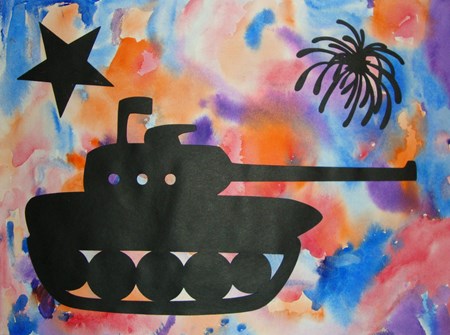The Color Wheel
Color theory has many definitions, concepts, and applications. The color wheel is one basic category of color theory.In this exercise, students studied the patterns of the color wheel and complimentary colors. They used these two aspects to create a name tag with fine-line illustration.
Complimentary colors are any two colors which are directly opposite of each other on the color wheel. These opposing colors create maximum contrast. On an elementary color wheel they are typically red and green, orange and blue, and yellow and purple.
Lines in Art
This project was a study of lines and how they can give dimension to a drawing. It was done to show students how they can take an ordinary object, like the hand, and turn it into something extraordinary, like the tree.This is a great lesson to tie in math--lines, points, planes. A line is a series of points or a path created by a moving point in space. It is one-dimensional and can vary in width, direction, and length. Lines often define the edges of a shape. They can be horizontal, vertical, diagonal, straight or curved, and thick or thin. They help to lead the observer's eye around the piece and communicate mood.
Geometry in Art
Geometry and art are very similar. Geometry can be found in all types of artwork such as quilts, sculpture, paintings, and even table lamps.In this lesson, students studied mandalas and geometric patterns and illustrated their learning. This is a great project for the beginning or advanced artist.
Perspective
Perspective was developed in the 15th century by architects. Perspective drawing has been a basic principle of art for 500 years until Cubists challenged it in the 20th century. It is an essential tool as an artist.There are two main elements of perspective drawing--1) Linear perspective, and 2) Aerial perspective.
Linear perspective deals with the orientation of shapes in space. Aerial perspective deals with effects of tone and colors. Both perspectives combine to create a 3D illusion on a 2D plane.
This is one of the favorite activities of my after-school art club. In this activity students learn to use perspective and begin by tracing their hands and feet. They then create self portraits focusing and detailing the tread of their shoes, the clothes they are wearing, and the lines in their hands, especially joints.
Aboriginal Dreaming
The Dreaming is a term used by Aborigines to describe the relationship and balance between spiritual, natural, and moral elements of the world. Their stories are much similar to those of North American Native American culture.Aboriginal art can focus on Aboriginal dreaming which uses symbols, dots, and illustrates a folktale. In this lesson, students focused on these elements of Aboriginal art to create their own pieces. They viewed videos of 3 examples of dreaming stories and analyzed different art samples from the Australian Museum of Art.
Watercolor Silhouettes
Silhouettes used to be called "shades," and sometimes "profiles," "likenesses," or "shadow pictures." They first appeared in the late 1600s as paper-cut profiles and were considered to be a great alternative to painted portraits.Wet-in-Wet is a water color technique where you apply pigment to wet paper. The results can have soft undefined shapes and slightly blurred marks. It depends on how wet the paper is.
Students create these works of art in October/November to display for Veterans' Day. Sometimes they give these creations as gifts to visiting veterans with a thank-you message on the back.













No comments:
Post a Comment